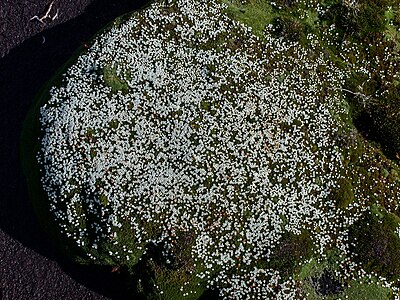bio.wikisort.org - Plant
Dracophyllum minimum, commonly known as heath cushionplant or claspleaf heath, is a species of bolster cushion plant endemic to Tasmania, Australia.[1][2] It is a low growing, highly compacted plant with white flowers, commonly found in alpine areas of the south, centre and west of Tasmania.[3]
Description
Dracophyllum minimum is a highly compacted cushion plant that grows close to the ground. It can form a large spreading mat, often interspersed with other cushion plant species such as Oreobolus pumilio, Abrotanella forsteroides, Donatia novae-zelandiae and Mitrasacme archeri. This undulating mat of mixed species is referred to as mosaic cushion heath.[4] The leaves of D. minimum are bright green and sessile, with reddish tips and a broad sheathing base as long as the blade, approx 3 to 4 mm (0.12 to 0.16 in).[4] The flowers are small, solitary, white, and tubular, sitting directly on top of the foliage.[5] The plant can often be mistaken for the vegetatively similar cushion plants Abrotanella forsterioides and Donatia novae-zelandieae, however D. minimum is distinguished by its lack of a hairpoint on the leaf tip or hairy leaf axils.[6] Cuchion plants are extremely slow growing and can occupy sites for a long period of time.[7]
- Flowering cushion of D. minimum on Mount Field
- Flowering D. minimum with P. lawrencii growing in between on Mount Field
Habitat
Dracophyllum minimum is endemic to Tasmania. It is commonly found in alpine regions of the south, centre and west of Tasmania, at altitudes above 1,200 m (3,900 ft), where snow may lie for several months of the year.[4] It is generally found on shallow fibrous peaty soils with high rainfall and poor drainage.[8] Dracophyllum minimum can grow individually, however it often occurs in cushion plant communities, consisting of a complex mix of cushion plant species, commonly 30 species/m2 (2.8 species/sq ft), forming an extensive undulating mat. These communities can spread up to several hectares in area.[4]
References
- "Species Dracophyllum minimum". Natural Values Atlas. Retrieved 15 March 2021.
- "Dracophyllum minimum F.Muell". www.gbif.org. GBIF. Retrieved 2021-03-20.
- "Dracophyllum minimum (Ericaceae) 2:261". Key To Tasmanian Vascular Plants. UTAS. Retrieved 16 March 2021.
- Gibson, Neil B (1988). "A study on the biology of four Tasmanian cushion species" (PDF). University of Tasmania Hobart.
- Howells, C (2012). Tasmania's Natural Flora, Second Edition. Tasmania's Natural Flora Editorial Committee: Tasmania.
- "EPACRIDACEAE Dracophyllum minimum". Key To Tasmanian Vascular Plants. University of Tasmania Hobart. Retrieved 16 March 2021.
- Kirkpatrick, James; Gibson, Neil (1992). "Dynamics of a Tasmanian Cushion Heath Community". Journal of Vegetation Science. 3 (5): 647–654. doi:10.2307/3235832. JSTOR 3235832. Retrieved 15 March 2021.
- Kitchener, Anne; Harris, Stephen (2005). From Forest to Fjaeldmark. Descriptions of Tasmania's Vegetation (PDF) (Volume 2 ed.). Department of Primary Industries, Water and Environment. ISBN 0-7246-6364-9. Retrieved 16 March 2021.
Другой контент может иметь иную лицензию. Перед использованием материалов сайта WikiSort.org внимательно изучите правила лицензирования конкретных элементов наполнения сайта.
WikiSort.org - проект по пересортировке и дополнению контента Википедии


